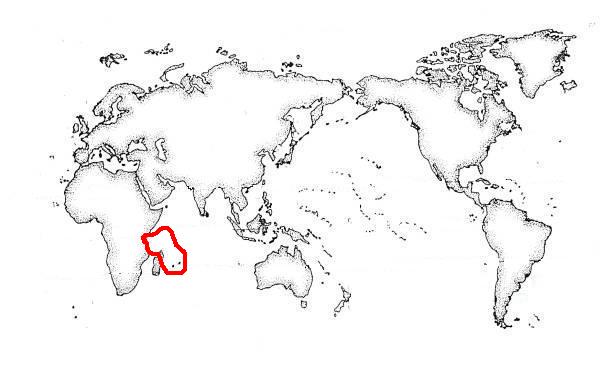
num. 7-12 dicembre 2008
 |
 |
Lambis ( Millepes) violacea (Swainson, 1821)
Distribuzione geografica - Geographical distribution
INDIAN OCEAN: Mauritius, Cargados Island, Zanzibar, Seychelles, Madagascar, RED SEA. Indonesia, Ambat, Madura.
|
Kreipl & Poppe (1999:22) dichiarano che le località di Reunion e Madagascar sono probabilmente errate, ad eccezione della località di Mauritius. Le altre provenienze, citate in letteratura, sembrano non chiare e controverse. Descrizione della specieLa formaE’ certamente una delle specie considerate rare e più belle del Genus Lambis, apprezzata per le sue caratteristiche ornamentali. Di dimensioni modeste, evidenzia la presenza di nove/dieci digitazioni labiali corte e con le punte arrotondate. La spira, non molto elevata, è composta da otto/nove giri spirali che alla sommità mostrano continui e regolari tubercoli. L’andamento generale della conchiglia, rispetto alla lunghezza generale, non è molto slanciato.La superficie dorsale è percorsa da evidenti cordoni spirali rilevati. Quelli in corrispondenza delle digitazioni aumentano considerevolmente di spessore specie per il primo cordone dell’ultimo giro che è costituito da tubercoli particolarmente rilevati. Presenza di bifidismo nella digitazione del canale posteriore. L’area ventrale ha forti ed evidenti callosità in prossimità del canale anteriore e verso il callo columellare. Apertura moderatamente ampia e profonda. Tutto il labbro e l’area parietale sono coperti da dense lirature più rade nel primo ed assai dense nel secondo. L’incavo stromboidale è forte, piccolo e scarsamente dentato. La colorazioneConchiglia di colorazione generalmente biancastra. La superficie mostra delle piccole maculature color bruno/marrone discontinue che si addensano, invece, in prossimità delle digitazioni labiali. L’apertura evidenzia tutta la sua bellezza con un color viola, simile a quello del vino rosso, assai intenso che è presente, in forma più sfumata, sulla sommità delle callosità parietali, mentre sul bordo del labbro esterno, in prossimità delle digitazioni labiali, esistono piccole macule di color arancio. L’area parietale, a differenza del dorso, evidenzia delle maculature di color marrone chiaro intervallate dai cordoni spirali.DimensioniLe segnalazioni relative alle dimensioni di questa specie non sono poi molte. Abbott (1961:167) riporta le dimensioni di 113.50 mm, per un esemplare proveniente da Mauritius. Walls (1980:69) riporta per L. violacea dimensioni che oscillano tra i 75/125 mm. Abbott & Dance (1986:81) segnalano le dimensioni di 90 mm. per questa specie. Kreipl & Poppe (1999:22) indicano le dimensioni comprese tra 70/145 mm.Nella collezione AMI è presente un esemplare (ST.08.01) dragato nelle acque di Mauritius delle dimensioni di 151, 78 mm. che costituisce l’esemplare di massime dimensioni presente nella nostra collezione. |
Kreipl & Poppe (1999:22) declare that the places of Reunion and Madagascar are probably wrong, except of the locality of Mauritius, the whole other places, quoted in literature, seem not clear and controversial.
Species DescriptionThe shapeIt is certainly considered one of the most rare and beautiful species of the Genus Lambis, appreciated for its ornamental characteristics. Of modest dimensions, it shows the presence of nine or ten short labial digitations with rounded off points. The spire, not very elevated, is composed of eight or nine spirals that show continuous and regular tubercles at the summit. The general form of the shell, in comparison to its general length, is not very slender.The dorsal surface is crossed by noticeable spiral and raised cords. The ones in correspondence with the digitations increase considerably in thickness, especially at the first cord of the last spiral, which is made of particularly raised tubercles. There is presence of bifidism in the digitation of the posterior canal. The ventral area has strong and evident callousness in proximity of the anterior canal and toward the columellar callous. The opening is moderately ample and deep. The whole lip and the parietal area are covered with dense lirae, thinner in the former and very dense in the latter. The stromboid cavity is strong, small and poorly denticulated. ColouringShell of generally whitish coloration. The surface shows some small discontinuous brownish maculations that grow thicker in proximity of the labial digitations. The aperture shows all its beauty of a violet color, similar to the color of red wine, very intense, which is present, in a softer form, on the summit of the parietal callousness, while on the edge of the external lip, in proximity of the labial digitations, there are small stains of orange color. The parietal area, unlike the back, shows some maculations of light brown alternated with the spiral cords.DimensionThe reports related to the dimensions of this species are not a lot of then. Abbott (1961:167) reports the dimensions of 113.50 mm, for a sample coming from Mauritius. Walls (1980:69) reports for L. violacea dimensions between the 75-125 mm. Abbott & Dance (1986:81) report the dimensions of 90 mm. for this species. Kreipl & Poppe (1999:22) reports the dimensions between 70-145 mm.In the A.M.I. collection a specimen it is present (ST.08.01) from the waters of Mauritius of the dimensions of 151,78 mm. what it constitutes the maximum dredged specimen in our collection. |
